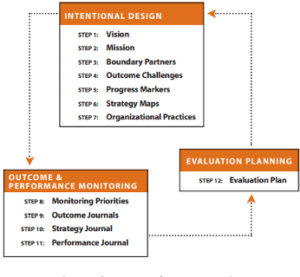Purpose: design and monitor which interventions are relevant to achieve a given (social) change
Who is it for: program and project managers
Technique: workshops
Type of tool: implementation tool
Prior knowledge: substantial
Complexity high
Time investment: days/weeks
Downloads
Links
Related tools
What is Outcome mapping?
Outcome mapping is a planning tool that focuses on the intended outcomes of a program. In contrast to traditional evaluation methods that focus primarily on quantifiable outputs and program outcomes, outcome mapping places a strong emphasis on outcomes in the form of change in behaviour, relationships, and activities of the individuals and organizations with whom the program works.
This planning tool concentrates on outcomes. These outcomes can be logically connected to the activities and outputs of a program, placing them partially within the program’s sphere of influence. However, their realization also heavily relies on interactions with the so-called ‘boundary partners’ situated at the interface of the program and the broader context where the change needs to be instigated.
How do you use Outcome mapping?
Outcome mapping is divided into 3 phases and 12 steps (see figure below). Workshops involving the various stakeholders and boundary partners will be used to address these steps. The original design of outcome mapping is based on a three-day workshop, but choices can be made about who to involve in which phases to avoid placing too much burden on the boundary partners. Below the figure, we briefly explain the steps to be followed in each phase.

Intentional Design (Step 1 – Step 7)
Intentional design means that a program frames its activities based on the outcomes it wants to help achieve. Its actions are purposefully chosen in order to maximize the effectiveness of its contributions to development. In this phase, the following questions are central to the workshop:
- Why do we do this? What is the underlying vision for the future to which the programme should contribute?
- Who are we doing this for? Who are the boundary partners?
- What do we want to achieve? In which areas do we want to contribute to the vision for the future with the programme and how can we track our progress?
- How are we going to do this? In what ways will this programme contribute to what we want to achieve?
In the intentional design phase, the following steps are followed in succession:
- Describe the vision: The vision reflects the large-scale changes to which the program hopes to contribute. The vision is related to the objectives of the programme, but goes deeper, has a broader scope and is focused on the longer term. The ultimate realisation of the vision is beyond the control of the programme, but the programme’s activities should contribute to it.
- Identify the mission: The mission statement outlines the areas in which the program will ideally contribute to the realization of the vision but does not list all the activities in which the program will be involved.
- Identify the boundary partners: Boundary partners are those individuals, groups, or organizations that the program needs in practice to realize its mission, but over whom it has no direct control.
- Identify the outcome challenge: An outcome challenge describes how a boundary partner’s behaviour, relationships, activities, or actions will change if the program is extremely successful. ‘Outcome challenges’ are formulated in a way that emphasizes behavioural change. They should be idealistic but realistic.
- Develop step-by-step progress indicators: Step-by-step progress indicators are identified for each of the outcomes that the program helps to achieve. They show the complexity of the change process associated with each boundary partner and represent the information that the program can gather to monitor performance towards the desired outcome.
- Create a strategy map for each outcome challenge: The goal of the strategy map is to identify the strategies used by the program to contribute to achieving the intended outcomes.
- Establish organizational practices: The goal of this step is to identify the organizational practices that the program will use to effectively contribute to achieving the outcomes.
Outcome & performance monitoring (Step 8 – Step 11)
In this phase of the workshop, participants will develop a framework for monitoring: the progress of boundary partner towards achieving outcomes, the programme’s strategies to support outcomes, and the organisational practices used.
- Setting monitoring priorities: not everything can be monitored and evaluated in view of the available financial and human resources. Therefore, choices have to be made about what will be continuously monitored and which aspects will be included in the evaluation.
- Developing an outcome journal: in order to keep track of the progress of the outcomes during the program implementation, an outcome journal is kept for each boundary partner in which the progress on the intended outcomes is described, and the extent and manner in which they have already been achieved.
- Develop a strategy journal: for the successful implementation of outcome mapping, the programme team will also need to be open to change itself in order to respond to the changing needs of its boundary partners. In a strategy journal, the team can track the experiences related to the strategies it has deployed to engage boundary partners.
- Develop a performance journal: by writing a performance journal, a program can systematically monitor its actions in support of its boundary partner. The performance log records data on how the program organization operates to fulfil its mission.
Evaluation planning (Step 12)
In the evaluation planning phase, evaluation priorities will have to be established prior to the preparation of an evaluation plan. This must be done because not everything can be evaluated within the available financial and human resources. Where possible, this will build on the monitoring products such as the logbooks and the underlying collected data. The ultimate goal of the evaluation is to inform future decisions about the (continuation of the) programme. The only step in this phase is:
- Develop an evaluation plan: The evaluation plan provides a brief description of the key elements of the evaluation to be conducted. It outlines the evaluation problem, the way in which the findings will be used, the questions, the sources of information, the evaluation methods, the evaluation team, the dates for the evaluation and the estimated costs.
What is the origin of Outcome mapping?
Outcome mapping is a methodology for monitoring and evaluation developed by the International Development Research Centre (IDRC) in collaboration with a team of professionals from the development field. It emerged as a response to the need for a more dynamic and participatory approach to measuring the impact of development programs.
The development of outcome mapping began in the early 1990s under the leadership of Sarah Earl, Fred Carden, and Terry Smutylo at the IDRC, a Canadian organization focused on supporting research and innovation in developing countries. They wanted to create an evaluation methodology that measures not only the outcomes of a program, but also the changes in the behaviour and relationships of the boundary partner directly involved in the program.
Since then, the IDRC and the outcome mapping Learning Community have contributed to further disseminating, adapting, and improving the methodology. Outcome mapping is now used globally by diverse organizations across industries, including international development, non-profit organizations, and government agencies, as an approach to understanding and improving the impact and contributions of their programs and interventions.





